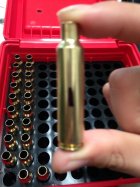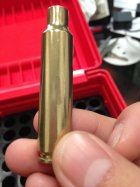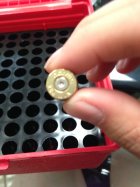Just wanted to share my findings over days of tedious brass weighing and data logging on and off since October.
_____________________________________________________________________________________
If you're lazy and don't want to read the post. Basically I feel H20 Weighing adds a tangible benefit and is superior to the more common method of weighing brass. This opinion is made on objective data that I've collected. I'll attach a spreadsheet that shows three different methods of weighing the same lot of brass (it's a very small sample, but these efforts have been repeated in a few hundred other pieces that I've weighed before I decided on record these findings for public viewing).
_____________________________________________________________________________________
These aren't new findings per say. These are simply my findings and opinions based on my observations.
Several High Masters and Masters in F-Class had given me much input from both Bayou Rifles and Panola County in Texas. It took me months to start back from scratch and start implementing the new techniques I'd learned...I'm still working on many new techniques on the reloading bench.
Brass Weighing is one of those techniques. Even among those qualified shooters there was a discrepancy as to how to weigh brass or the usefulness. Some hydro weighed and some didn't. I was told by some that I needed to get other facets of my game in order before I worried about weighing bullets or weighing brass.
One of which was to purchase a scientific scale able to weigh powder drops more accurately than my Chargemaster would be able to.
I see plenty of spendy electronic scales for sale on the classifieds and have spent my own hard earned money to now meter and weigh powder precisely to 0.02grs vs +/- 0.1 with the Chargemaster. I can't definitely say if 0.1 grain difference in case volume has the same effect as 0.1 grain of powder.
However, in this experiment I found an Extreme spread of 0.9grains when weighing with a primer pocket plug using premium Norma brass that had been fire formed to my chamber.
I feel I can safely surmise that a difference of almost 1.0 grain of internal volume between one shot and a second shot would result in a greater velocity change than +/-0.1 grains difference in powder drop.
However, it is tough to determine at what level one should start weighing internal volume. I have heard of older shooters making High Master while still dropping powder with an older style powder hopper and without weighing charges. This was conversation in the pits, and I don't remember the shooter's name that was referenced so I can't validate these claims.
I can validate that I made Mid-Range Master using an RCBS Chargemaster and without weighing internal case volume at last year's State match. I fell 3 points short of making Mid-Range High Master. Inexperience and Inadequate load development were my limiting factors not case weighing or the Chargemaster.
__________________________________________________________________________________
H20 (Internal Volume) weighing VS. Weighing the case: "Hornady" PDF cooresponds
We all know brass has varying thickness even among the highest quality brass. The changes in thickness effect the overall weight of the piece of brass. The supporting theory is that heavier brass = thicker walls = less internal volume. In my findings, there is a weak correlation with that assumption and there is no consistency with heavier brass having a lower internal volume. I found this very early on as I started experimenting with H20 weighing.
Attachment 1 - Will show Hornady brass I weighed today that proves this. Case weights vary significantly more than Norma brass, but internal volume happens to be better than the Fire Formed Norma brass. I suspect this is because the Hornady Brass is new. It is my understanding from reports by people such as Charles Ballard that Unfired Brass will produce the lowest ES. Unfortunately, I did not weigh the Norma brass prior to fire forming, but I suspect if I had the Norma brass would have provided more consistent results that the Hornady.
Weighing with Water vs. Salt or similar substance:
Liquid is the way to go here. I initially thought Salt or Sand would be superior and tried experimenting with it. I found granules have settling issues. Readings were not repeatable. When reweighing a batch of about 70 pieces of brass I found that a piece of brass could vary as much as 0.7grs from one weighing to the next, depending on how you tapped it. I tried using an electric toothbrush, tapping the table, finger flicking, tried covering the mouth of the brass and rapping the case aggressively to cause complete settling. This process was time consuming, messy, and inconsistent. I decided to go back to water weighing.
How to plug the brass: "Norma 284 Comparison" - Corresponds with this data.
Option 1: Reverse a fired primer (tip for forums)
Option 2: Weigh a UNcleaned fired piece of brass with the discharged primer
Option 3: Weigh a cleaned (wet tumbled) and fired piece of brass with discharged primer
Option 4: 21st Century Shooting Primer Plug
Option 1: As far as reversing primers and seating them upside-down as a cost effective option. This is by far the most dirty and tedious of the options. This is what directed me to break down and buy the 21st Century Plug. It's dirty, anvils fall out and get into the carpet and it's hard to seat the primers upside down without crushing the thin primer material. No mention of the trace lead residue and carbon you're handling. I strongly suggest you don't waste your time with this method.
Option 2: No surprise dirty brass was the least consistent. I've been told that the carbon will take up some case space and give you a false reading. However, with the primer still in place I actually got HIGHER readings than with the plug. The extra capacity is likely explained by the extra volume created by the primer cup.
Option 3: Brass was wet tumbled 1-hour. I was able to get more consistent readings among the same lot of brass. Readings were the highest likely due to the removal of the carbon, and the extra volume of the primer cup.
Option 4: The 21st Century primer plug is very repeatable in re-weighing the same brass with good technique however, it's a PITA. I wanted to see if the 21st Century primer plug actually made a difference in getting consistent readings versus the other options...and it does by a significant margin. Measuring with the 21st Century primer plug posted the smallest extreme spread and by far the most consistent results in terms of SDev.
As a mini-review. The primer plug was found the be the best tool to accurately weigh internal case volume using H20. It's fairly cheap $13ish, takes a little bit of learning (twist, don't force the plug in or you'll tear up an O-ring (you get a few spares), John also recommended wetting the O-ring, he said he'll dab his with his tongue. I find it usually stays wet from the previous piece of brass. I may reserve a full review for another post. After twisting the plug in you'll have to remember to weigh the brass and plug before filling up with water. Otherwise you'll get a false reading as some water residue stays in the piece of brass. Approximately .4-.6grains high. John was very helpful and actually sent me more O-rings free of charge when I let him know I was having issues. He didn't know I would be writing a review. I wasn't actually planning on it, but I guess I'd better.
Set Up:
Norma .284 Brass, Brass was fire formed to my chamber.
Room Temperature Water
A&D FX120i (Initial readings were rounded up or down. 2nd decimal place with 21st Plug as it appeared more accurate.)
Numbered brass from 1-21 with a sharpie.
Water bottle with small hole is used to drip water. I stopped using the powder funnel since it occasionally created large air pockets and gave false readings.
Initial weighing with dirty brass
Brass Wet Tumbled in a Thumlers for 1-hour. Still had a faint marking so I could keep track of individual pieces of brass.
Weighed Cleaned, than deprimed and retumbled for 30-mins.
Dried and a couple hours later re-weighed with 21st primer plug

Couple Notes:
-Note Primer weights vary +/- 0.15gr and can introduce weighing error.
-A couple times I accidentally poured water before weighing the brass by itself. I would dry the piece of brass as best as possible and weigh the "empty" case.
-Using Powder funnel to pour water. Creates an air bubble effect You can use a pen or case mouth as a "plunger".
-When using brass with fired primers. Tapping the brass becomes necessary. Small air bubbles collect in the primer and you will get false readings.
-Members here have stated a drop of soap will prevent bubbles
-If you have an inconsistent fill your readings can vary by more than half a grain. This is about 1 small drip of water over.
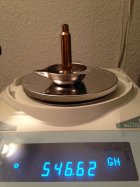
-I use my driver's license to get rid of excess water at the case mouth. This is a very important step in the entire process.

-Properly filled for a consistent weighing between cases.
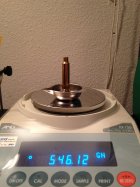
Full disclosure. H20 brass weighing is very time consuming and about as fun as watching paint dry. This reloading technique has a diminishing return in the amount of time you invest. If you're still a novice shooter I can guarantee you can find bigger gains by addressing other parts of your game and equipment.
I plan on competing in Long-Range this year and I'm trying to get to single digit ES which I'm not even close, so I feel this is necessary for me.
_____________________________________________________________________________________
If you're lazy and don't want to read the post. Basically I feel H20 Weighing adds a tangible benefit and is superior to the more common method of weighing brass. This opinion is made on objective data that I've collected. I'll attach a spreadsheet that shows three different methods of weighing the same lot of brass (it's a very small sample, but these efforts have been repeated in a few hundred other pieces that I've weighed before I decided on record these findings for public viewing).
_____________________________________________________________________________________
These aren't new findings per say. These are simply my findings and opinions based on my observations.
Several High Masters and Masters in F-Class had given me much input from both Bayou Rifles and Panola County in Texas. It took me months to start back from scratch and start implementing the new techniques I'd learned...I'm still working on many new techniques on the reloading bench.
Brass Weighing is one of those techniques. Even among those qualified shooters there was a discrepancy as to how to weigh brass or the usefulness. Some hydro weighed and some didn't. I was told by some that I needed to get other facets of my game in order before I worried about weighing bullets or weighing brass.
One of which was to purchase a scientific scale able to weigh powder drops more accurately than my Chargemaster would be able to.
I see plenty of spendy electronic scales for sale on the classifieds and have spent my own hard earned money to now meter and weigh powder precisely to 0.02grs vs +/- 0.1 with the Chargemaster. I can't definitely say if 0.1 grain difference in case volume has the same effect as 0.1 grain of powder.
However, in this experiment I found an Extreme spread of 0.9grains when weighing with a primer pocket plug using premium Norma brass that had been fire formed to my chamber.
I feel I can safely surmise that a difference of almost 1.0 grain of internal volume between one shot and a second shot would result in a greater velocity change than +/-0.1 grains difference in powder drop.
However, it is tough to determine at what level one should start weighing internal volume. I have heard of older shooters making High Master while still dropping powder with an older style powder hopper and without weighing charges. This was conversation in the pits, and I don't remember the shooter's name that was referenced so I can't validate these claims.
I can validate that I made Mid-Range Master using an RCBS Chargemaster and without weighing internal case volume at last year's State match. I fell 3 points short of making Mid-Range High Master. Inexperience and Inadequate load development were my limiting factors not case weighing or the Chargemaster.
__________________________________________________________________________________
H20 (Internal Volume) weighing VS. Weighing the case: "Hornady" PDF cooresponds
We all know brass has varying thickness even among the highest quality brass. The changes in thickness effect the overall weight of the piece of brass. The supporting theory is that heavier brass = thicker walls = less internal volume. In my findings, there is a weak correlation with that assumption and there is no consistency with heavier brass having a lower internal volume. I found this very early on as I started experimenting with H20 weighing.
Attachment 1 - Will show Hornady brass I weighed today that proves this. Case weights vary significantly more than Norma brass, but internal volume happens to be better than the Fire Formed Norma brass. I suspect this is because the Hornady Brass is new. It is my understanding from reports by people such as Charles Ballard that Unfired Brass will produce the lowest ES. Unfortunately, I did not weigh the Norma brass prior to fire forming, but I suspect if I had the Norma brass would have provided more consistent results that the Hornady.
Weighing with Water vs. Salt or similar substance:
Liquid is the way to go here. I initially thought Salt or Sand would be superior and tried experimenting with it. I found granules have settling issues. Readings were not repeatable. When reweighing a batch of about 70 pieces of brass I found that a piece of brass could vary as much as 0.7grs from one weighing to the next, depending on how you tapped it. I tried using an electric toothbrush, tapping the table, finger flicking, tried covering the mouth of the brass and rapping the case aggressively to cause complete settling. This process was time consuming, messy, and inconsistent. I decided to go back to water weighing.
How to plug the brass: "Norma 284 Comparison" - Corresponds with this data.
Option 1: Reverse a fired primer (tip for forums)
Option 2: Weigh a UNcleaned fired piece of brass with the discharged primer
Option 3: Weigh a cleaned (wet tumbled) and fired piece of brass with discharged primer
Option 4: 21st Century Shooting Primer Plug
Option 1: As far as reversing primers and seating them upside-down as a cost effective option. This is by far the most dirty and tedious of the options. This is what directed me to break down and buy the 21st Century Plug. It's dirty, anvils fall out and get into the carpet and it's hard to seat the primers upside down without crushing the thin primer material. No mention of the trace lead residue and carbon you're handling. I strongly suggest you don't waste your time with this method.
Option 2: No surprise dirty brass was the least consistent. I've been told that the carbon will take up some case space and give you a false reading. However, with the primer still in place I actually got HIGHER readings than with the plug. The extra capacity is likely explained by the extra volume created by the primer cup.
Option 3: Brass was wet tumbled 1-hour. I was able to get more consistent readings among the same lot of brass. Readings were the highest likely due to the removal of the carbon, and the extra volume of the primer cup.
Option 4: The 21st Century primer plug is very repeatable in re-weighing the same brass with good technique however, it's a PITA. I wanted to see if the 21st Century primer plug actually made a difference in getting consistent readings versus the other options...and it does by a significant margin. Measuring with the 21st Century primer plug posted the smallest extreme spread and by far the most consistent results in terms of SDev.
As a mini-review. The primer plug was found the be the best tool to accurately weigh internal case volume using H20. It's fairly cheap $13ish, takes a little bit of learning (twist, don't force the plug in or you'll tear up an O-ring (you get a few spares), John also recommended wetting the O-ring, he said he'll dab his with his tongue. I find it usually stays wet from the previous piece of brass. I may reserve a full review for another post. After twisting the plug in you'll have to remember to weigh the brass and plug before filling up with water. Otherwise you'll get a false reading as some water residue stays in the piece of brass. Approximately .4-.6grains high. John was very helpful and actually sent me more O-rings free of charge when I let him know I was having issues. He didn't know I would be writing a review. I wasn't actually planning on it, but I guess I'd better.
Set Up:
Norma .284 Brass, Brass was fire formed to my chamber.
Room Temperature Water
A&D FX120i (Initial readings were rounded up or down. 2nd decimal place with 21st Plug as it appeared more accurate.)
Numbered brass from 1-21 with a sharpie.
Water bottle with small hole is used to drip water. I stopped using the powder funnel since it occasionally created large air pockets and gave false readings.
Initial weighing with dirty brass
Brass Wet Tumbled in a Thumlers for 1-hour. Still had a faint marking so I could keep track of individual pieces of brass.
Weighed Cleaned, than deprimed and retumbled for 30-mins.
Dried and a couple hours later re-weighed with 21st primer plug

Couple Notes:
-Note Primer weights vary +/- 0.15gr and can introduce weighing error.
-A couple times I accidentally poured water before weighing the brass by itself. I would dry the piece of brass as best as possible and weigh the "empty" case.
-Using Powder funnel to pour water. Creates an air bubble effect You can use a pen or case mouth as a "plunger".
-When using brass with fired primers. Tapping the brass becomes necessary. Small air bubbles collect in the primer and you will get false readings.
-Members here have stated a drop of soap will prevent bubbles
-If you have an inconsistent fill your readings can vary by more than half a grain. This is about 1 small drip of water over.

-I use my driver's license to get rid of excess water at the case mouth. This is a very important step in the entire process.

-Properly filled for a consistent weighing between cases.

Full disclosure. H20 brass weighing is very time consuming and about as fun as watching paint dry. This reloading technique has a diminishing return in the amount of time you invest. If you're still a novice shooter I can guarantee you can find bigger gains by addressing other parts of your game and equipment.
I plan on competing in Long-Range this year and I'm trying to get to single digit ES which I'm not even close, so I feel this is necessary for me.
Attachments
Last edited:










